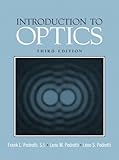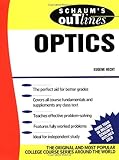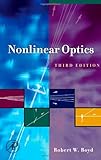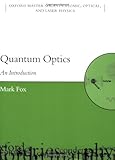|
|
Help |
| Home - Technology - Optics (Books) | |
e99 Online Shopping Mall
|
|
Help |
| Home - Technology - Optics (Books) | |
| 1-20 of 100 | Next 20 |
click price to see details click image to enlarge click link to go to the store
| 1. Introduction to Modern Optics by Grant R. Fowles | |
 | Paperback: 336
Pages
(1989-06-01)
list price: US$16.95 -- used & new: US$9.96 (price subject to change: see help) Asin: 0486659577 Average Customer Review: Canada | United Kingdom | Germany | France | Japan |
|
Editorial Review Product Description Customer Reviews (11)
| |
| 2. FOA Reference Guide to Fiber Optics: Study Guide to FOA Certification by Jim Hayes | |
 | Paperback: 192
Pages
(2009-09-04)
list price: US$24.95 -- used & new: US$21.56 (price subject to change: see help) Asin: 1439253870 Average Customer Review: Canada | United Kingdom | Germany | France | Japan |
|
Editorial Review Product Description Customer Reviews (2)
| |
| 3. Optics (4th Edition) by Eugene Hecht | |
 | Hardcover: 680
Pages
(2001-08-12)
list price: US$148.20 -- used & new: US$114.98 (price subject to change: see help) Asin: 0805385665 Average Customer Review: Canada | United Kingdom | Germany | France | Japan |
|
Editorial Review Product Description Customer Reviews (37)
| |
| 4. Introduction to Fourier Optics by Joseph W. Goodman | |
 | Hardcover: 491
Pages
(2004-12-10)
list price: US$98.50 -- used & new: US$48.00 (price subject to change: see help) Asin: 0974707724 Average Customer Review: Canada | United Kingdom | Germany | France | Japan |
|
Editorial Review Product Description Customer Reviews (11)
| |
| 5. Introduction to Optics (3rd Edition) by Frank L Pedrotti, Leno M Pedrotti, Leno S Pedrotti | |
 | Hardcover: 656
Pages
(2006-04-17)
list price: US$149.80 -- used & new: US$115.06 (price subject to change: see help) Asin: 0131499335 Average Customer Review: Canada | United Kingdom | Germany | France | Japan |
|
Editorial Review Product Description Comprehensive and fully updated, this reader-friendly introduction to optics provides clear, concise derivations and explanations of optical phenomena, avoiding extraneous material. Updates material related to laser systems. Updated chapters on Optical Interferometery, Fiber Optics, and Holography. Introduces a broad range of new applications throughout, including liquid crystal displays, CCD's, CD and DVD Technology. Features a more intensive exploration of communication systems than in previous editions. Provides approximately 50 new problems and 50 new or revised figures. A general reference for optical industry practitioners. Customer Reviews (8)
| |
| 6. Schaum's Outline of Optics by Eugene Hecht | |
 | Paperback: 256
Pages
(1974-11-01)
list price: US$19.95 -- used & new: US$12.62 (price subject to change: see help) Asin: 0070277303 Average Customer Review: Canada | United Kingdom | Germany | France | Japan |
|
Editorial Review Product Description Customer Reviews (8)
| |
| 7. The FOA Reference Guide to Outside Plant Fiber Optics by Jim Hayes | |
 | Paperback: 260
Pages
(2010-06-30)
list price: US$27.95 -- used & new: US$27.95 (price subject to change: see help) Asin: 1450559670 Canada | United Kingdom | Germany | France | Japan |
|
Editorial Review Product Description | |
| 8. Nonlinear Optics, Third Edition by Robert W. Boyd | |
 | Hardcover: 640
Pages
(2008-04-11)
list price: US$104.00 -- used & new: US$56.41 (price subject to change: see help) Asin: 0123694701 Average Customer Review: Canada | United Kingdom | Germany | France | Japan |
|
Editorial Review Product Description Customer Reviews (14)
| |
| 9. Principles of Optics: Electromagnetic Theory of Propagation, Interference and Diffraction of Light (7th Edition) by Max Born, Emil Wolf | |
 | Hardcover: 986
Pages
(1999-10-13)
list price: US$98.00 -- used & new: US$74.50 (price subject to change: see help) Asin: 0521642221 Average Customer Review: Canada | United Kingdom | Germany | France | Japan |
|
Editorial Review Product Description Customer Reviews (10)
However, it is hard to read and use a weird notation. Certainly not useful for rapid referencing. Like the bible, use it only when you have serious problem to deal with. ... Read more | |
| 10. Fiber Optics Technician's Manual by Jim Hayes | |
 | Paperback: 288
Pages
(2010-03-11)
list price: US$87.95 -- used & new: US$55.58 (price subject to change: see help) Asin: 1435499654 Average Customer Review: Canada | United Kingdom | Germany | France | Japan |
|
Editorial Review Product Description Customer Reviews (10)
| |
| 11. Last-Minute Optics: A Concise Review of Optics, Refraction, and Contact Lenses by David G. Hunter PhDMD, Constance E. West MD | |
 | Paperback: 144
Pages
(2010-04-15)
list price: US$47.95 -- used & new: US$40.00 (price subject to change: see help) Asin: 1556429274 Average Customer Review: Canada | United Kingdom | Germany | France | Japan |
|
Editorial Review Product Description The popular optics review manual, Last-Minute Optics: A Concise Review of Optics, Refraction, and Contact Lenses, has been revised and updated into a Second Edition. This unique resource boils down the overwhelming subject matter of clinical optics and refraction, helping the ophthalmologist cover the essentials in a single review manual. The content is based upon the practical experience of two clinically active experts who lecture on ophthalmic optics around the world. This updated Second Edition by Drs. David G. Hunter and Constance E. West includes new questions added to selected chapters and a new chapter covering refractive surgery, as well as a key chapter that helps you evaluate patients with symptoms related directly to optical or refractive concerns. The complex concepts of optics are revealed in easy-to-understand explanations enhanced by simple illustrations. Last-Minute Optics, Second Edition allows you to test your knowledge while increasing your understanding of optics. Designed in a clear, concise, question-and-answer format, this book allows for self-assessment and a chance to test your understanding before you read the answer. Features of the Second Edition: • Written in a light and approachable style to make optics accessible and understandable Whether you’re an ophthalmologist, ophthalmic technician, resident or student, reviewing the optics facts and concepts is easier with Last-Minute Optics: A Concise Review of Optics, Refraction, and Contact Lenses, Second Edition. Customer Reviews (4)
As alearning tool it is also lacking, with little detail or helpfuldiagrams. However, as a study tool, this review should serve the student well if he/she had a real reference from which to learn.That is, in fact, what it markets itself to be -- a last minute study review -- so no false advertising here. Kirk Carver, Patient Advocate,... ... Read more | |
| 12. Introduction to Quantum Optics: From the Semi-classical Approach to Quantized Light by Gilbert Grynberg, Alain Aspect, Claude Fabre | |
 | Hardcover: 696
Pages
(2010-10-18)
list price: US$80.00 -- used & new: US$69.90 (price subject to change: see help) Asin: 0521551129 Canada | United Kingdom | Germany | France | Japan |
|
Editorial Review Product Description | |
| 13. Fiber Optic Reference Guide, Third Edition by David Goff | |
 | Paperback: 260
Pages
(2002-03-29)
list price: US$69.95 -- used & new: US$61.13 (price subject to change: see help) Asin: 0240804864 Average Customer Review: Canada | United Kingdom | Germany | France | Japan |
|
Editorial Review Product Description Customer Reviews (4)
The book was laid out logically, and did a good job of building on knowledge explained in previous chapters.There were one page summaries at the tale of each chapter, which were helpful in allowing you to either skip or skim the text. The glossary at the end of the book was especially useful, as was the end chapter on future trends within the industry.The book was a quick read, and once I had finished it I felt comfortable engaging in a discussion with people much more accomplished in the field than myself. ... Read more | |
| 14. Field Guide to Geometrical Optics (SPIE Vol. FG01) by John E. Greivenkamp | |
 | Spiral-bound: 128
Pages
(2003-12)
list price: US$37.00 -- used & new: US$37.00 (price subject to change: see help) Asin: 0819452947 Average Customer Review: Canada | United Kingdom | Germany | France | Japan |
|
Editorial Review Product Description Customer Reviews (4)
| |
| 15. Quantum Optics: An Introduction (Oxford Master Series in Physics, 6) by Mark Fox | |
 | Paperback: 400
Pages
(2006-06-22)
list price: US$65.00 -- used & new: US$38.47 (price subject to change: see help) Asin: 0198566735 Average Customer Review: Canada | United Kingdom | Germany | France | Japan |
|
Editorial Review Product Description Customer Reviews (5)
| |
| 16. The Geometrical Optics Workbook by David S. Loshin ODPhD | |
 | Paperback: 202
Pages
(1991-05-06)
list price: US$65.95 -- used & new: US$62.94 (price subject to change: see help) Asin: 0750690526 Average Customer Review: Canada | United Kingdom | Germany | France | Japan |
|
Editorial Review Product Description Customer Reviews (1)
| |
| 17. Seeing the Light: Optics in Nature, Photography, Color, Vision, and Holography by David R. Falk, Dieter R. Brill, David G. Stork | |
 | Hardcover: 446
Pages
(1986-11-01)
-- used & new: US$84.98 (price subject to change: see help) Asin: 0471603856 Average Customer Review: Canada | United Kingdom | Germany | France | Japan |
|
Editorial Review Product Description Customer Reviews (8)
| |
| 18. City of Light: The Story of Fiber Optics (Sloan Technology Series) by Jeff Hecht | |
 | Paperback: 368
Pages
(2004-04-08)
list price: US$24.95 -- used & new: US$4.49 (price subject to change: see help) Asin: 0195162552 Average Customer Review: Canada | United Kingdom | Germany | France | Japan |
|
Editorial Review Product Description Customer Reviews (7)
I would particularly recommend the book tofiber optic techies - it really makes the technology more meaningful whenyou understand how the technology developed.A fine job by a good writer -very close to five stars. And if you're technically oriented and wantmore knowledge of fiber optic technology, I'd recommend "OpticalNetworks" by Ramaswami and Sivarajan.
| |
| 19. Optics Demystified by Stan Gibilisco | |
 | Paperback: 368
Pages
(2009-06-22)
list price: US$24.95 -- used & new: US$14.19 (price subject to change: see help) Asin: 0071494499 Average Customer Review: Canada | United Kingdom | Germany | France | Japan |
|
Editorial Review Product Description An enlightening guide to optics Are you in the dark when it comes to understanding the science of optics? Now there's a glimmer in the gloom! Optics Demystified brings this challenging topic into focus. Written in an easy-to-follow format, this practical guide begins by covering the nature of light, the electromagnetic spectrum, reflection, refraction, and color dispersion. You'll move on to common optical devices and effects, lasers, and optical data transmission technology. Industrial, medical, and military applications are discussed, as are exotic optics such as holography. Detailed examples and concise explanations make it easy to understand the material, and end-of-chapter quizzes and a final exam help reinforce learning. It's a no-brainer! You'll get: Simple enough for a beginner but challenging enough for an advanced student, Optics Demystified illuminates this vital physics topic. Customer Reviews (1)
| |
| 20. Principles of Adaptive Optics, Third Edition (Series in Optics and Optoelectronics) by Robert Tyson | |
 | Hardcover: 314
Pages
(2010-09-14)
list price: US$89.95 -- used & new: US$60.71 (price subject to change: see help) Asin: 1439808589 Canada | United Kingdom | Germany | France | Japan |
|
Editorial Review Product Description Since the publication of the second edition of Principles of Adaptive Optics, the developments and applications in this area have increased tremendously. Observatories are now producing outstanding science through adaptive optics technology; components, such as micromachined deformable mirrors and very low noise detectors, are revolutionizing the field; and the industrial and medical arenas are harnessing the capabilities of adaptive optics tools in free-space laser communications, laser-induced fusion, and retinal imaging. Although the complexity of these applications has intensified, the principles essentially remain the same. Principles of Adaptive Optics, Third Edition offers a comprehensive guide to the systems, components, and processes of adaptive optics. It covers the principles used to extract information from beams of light and improve the performance of optical systems by correcting distortions and aberrations. Condensing the vast array of literature into one accessible source, this edition incorporates recent developments and adds many new references. It discusses how the principles are applied to astronomical imaging systems, retinal imaging, and beam propagation systems. The book logically progresses from determining the sources of aberrations to designing and analyzing systems to describing major subsystems, such as wavefront sensors, correction devices, wavefront reconstruction, and real-time controls. | |
| 1-20 of 100 | Next 20 |